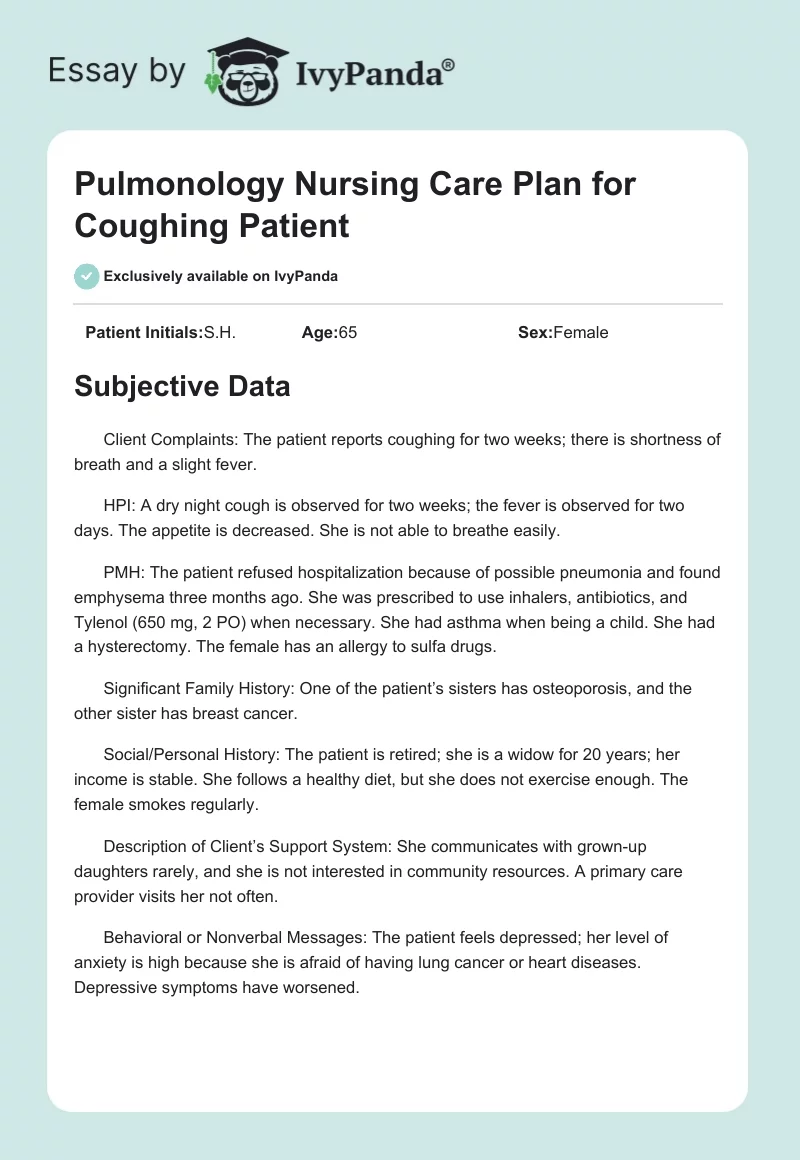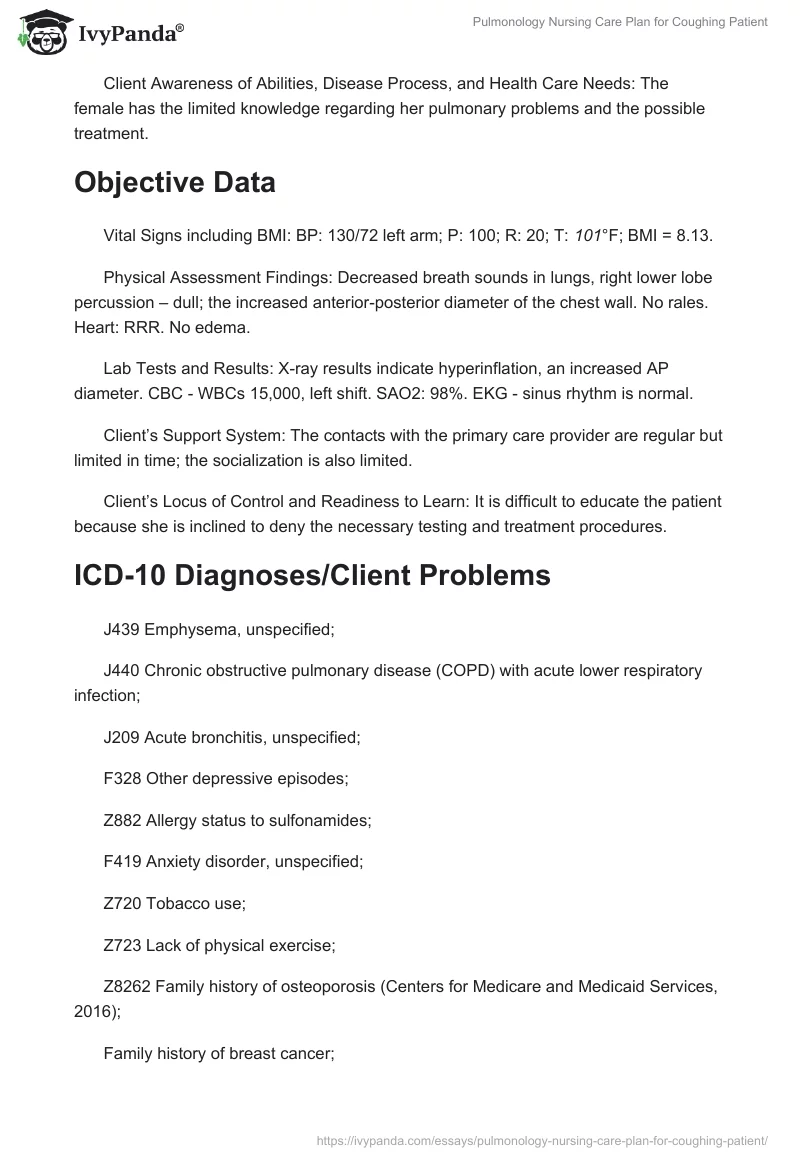Subjective Data
Client Complaints: The patient reports coughing for two weeks; there is shortness of breath and a slight fever.
HPI: A dry night cough is observed for two weeks; the fever is observed for two days. The appetite is decreased. She is not able to breathe easily.
PMH: The patient refused hospitalization because of possible pneumonia and found emphysema three months ago. She was prescribed to use inhalers, antibiotics, and Tylenol (650 mg, 2 PO) when necessary. She had asthma when being a child. She had a hysterectomy. The female has an allergy to sulfa drugs.
Significant Family History: One of the patient’s sisters has osteoporosis, and the other sister has breast cancer.
Social/Personal History: The patient is retired; she is a widow for 20 years; her income is stable. She follows a healthy diet, but she does not exercise enough. The female smokes regularly.
Description of Client’s Support System: She communicates with grown-up daughters rarely, and she is not interested in community resources. A primary care provider visits her not often.
Behavioral or Nonverbal Messages: The patient feels depressed; her level of anxiety is high because she is afraid of having lung cancer or heart diseases. Depressive symptoms have worsened.
Client Awareness of Abilities, Disease Process, and Health Care Needs: The female has the limited knowledge regarding her pulmonary problems and the possible treatment.
Objective Data
Vital Signs including BMI: BP: 130/72 left arm; P: 100; R: 20; T: 101°F; BMI = 8.13.
Physical Assessment Findings: Decreased breath sounds in lungs, right lower lobe percussion – dull; the increased anterior-posterior diameter of the chest wall. No rales. Heart: RRR. No edema.
Lab Tests and Results: X-ray results indicate hyperinflation, an increased AP diameter. CBC – WBCs 15,000, left shift. SAO2: 98%. EKG – sinus rhythm is normal.
Client’s Support System: The contacts with the primary care provider are regular but limited in time; the socialization is also limited.
Client’s Locus of Control and Readiness to Learn: It is difficult to educate the patient because she is inclined to deny the necessary testing and treatment procedures.
ICD-10 Diagnoses/Client Problems
J439 Emphysema, unspecified;
J440 Chronic obstructive pulmonary disease (COPD) with acute lower respiratory infection;
J209 Acute bronchitis, unspecified;
F328 Other depressive episodes;
Z882 Allergy status to sulfonamides;
F419 Anxiety disorder, unspecified;
Z720 Tobacco use;
Z723 Lack of physical exercise;
Z8262 Family history of osteoporosis (Centers for Medicare and Medicaid Services, 2016);
Family history of breast cancer;
Personal history of asthma.
Advanced Practice Nursing Intervention Plan
Goal and Outcomes: The patient will cope with the infection; the gas exchange will be controlled; the patient will cope with depression and give up smoking; the patient will gain weight.
Patient Involvement: The patient will be educated regarding the necessity of additional diagnostics and the therapeutic care and management to prevent the worsening symptoms. The patient will control the weight at home and follow the medication therapy.
- Diagnostic Tests: (1) laboratory testing to determine the infection causing acute bronchitis; (2) pulmonary function tests (PFTs); (3) CBC with differential; (4) screening for depression; (5) chest CT.
- Medications: Continue taking Tylenol 650 mg, by mouth as needed; start taking antibiotics (not including sulfonamides) to address the determined infection and bronchodilators, once a day. Start taking antidepressants if the depression screening is positive.
- Conservative treatments: The patient should focus on giving up smoking. The O2 therapy and the use of inhalers are recommended. The female should weigh every day and control changes in a diary. The enhancement of nutrition and pulmonary rehabilitation are also recommended.
- Education: The education plan should include the developed diet presented for the patient as a brochure to consult; the plan for the smoking cessation; and the exercise program to address the physical inactivity. The focus is on light aerobic activities and walking. Written and verbal instructions on taking medications and following exercises and the diet should be provided.
- Collaboration and referrals: (1) Pulmonologist – to conduct necessary testing; (2) Nutritionist – to improve the diet; (3) Psychologist – to receive the counseling regarding depressive symptoms; (4) Community Services – to participate in smoking cessation programs.
- Follow-up: in a week after taking antibiotics – to check the temperature and conduct the chest investigation; in three weeks – to evaluate the weight, as well as heart and respiratory rates; in a month – to check WBC and changes in SAO2.
Rationale: In terms of diagnostics, PFTs are most appropriate to monitor the progress of COPD and check the oxygen consumption. It is also necessary to monitor changes in SAO2 and PAO2 in order to control the possible development of the impaired gas exchange (Mascalchi, 2015). Controlling CBC and WBC is necessary to predict the further development of the lung infection and associated diseases, including acute bronchitis and pneumonia, because it is a risk factor for the elderly people (Clark, Medina, Batham, Curran, & Parmar, 2014). The screening for depression is required because the patient’s management of COPD depends on this factor, and the consultation with the psychologist is important to address the patient’s anxiety (Zockler, Rief, Stenzel, Kuhl, & Kenn, 2012).
The choice of medications is based on the necessity to help the patient cope with the infection, breathe easier, and overcome depressive symptoms. It is important for the patient to follow the nutritional plan because she suffers from the extreme thinness. It is possible to take nutritional supplements (Collins, Stratton, & Elia, 2014). The cooperation with the pulmonologist is necessary to monitor the development of COPD and the O2 saturation.
References
Centers for Medicare and Medicaid Services. (2016). 2016 ICD-10-CM and GEMs. Web.
Clark, T. W., Medina, M. J., Batham, S., Curran, M. D., & Parmar, S. (2014). Adults hospitalised with acute respiratory illness rarely have detectable bacteria in the absence of COPD or pneumonia; viral infection predominates in a large prospective UK sample. Journal of Infection, 69(5), 507-515.
Collins, P. F., Stratton, R. J., & Elia, M. (2014). Nutritional support in chronic obstructive Pulmonary Disease (COPD) a randomised trial. Clinical Nutrition, 33(1), 65-74.
Mascalchi, M. (2015). Pulmonary function tests and computed tomography lung attenuation in chronic obstructive pulmonary disease. Journal of Thoracic Disease, 7(11), 1882-1889.
Zockler, N., Rief, W., Stenzel, N., Kuhl, K., & Kenn, K. (2012). Do illness beliefs predict depression and quality of life after pulmonary rehabilitation? European Respiratory Journal, 40(56), 1472-1489.


